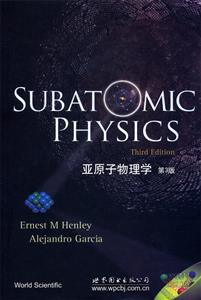亚原子物理学-第3版

|
亚原子物理学-第3版作者:亨利 开 本:24开 书号ISBN:9787510086359 定价:99.0 出版时间:2015-01-01 出版社:世界图书出版公司 |
亚原子物理学-第3版 内容简介
Subatomic Physics, the physics of nuclei and particles, has been one of the frontiers of science since its birth in 1896. From the study of the radiations emitted by radioactive nuclei to the scattering experiments that point to the presence of subLuuts in nucleons, from the discovery of the hadroruc interactions to the real-ization that the photon possesses hadronic (strong) attributes, and that weak and electromagnetic forces may be intimately related, subatomic physics has enriched science with new concepts and deeper insights into the laws of nature. Subatomic Physics does not stand isolated; it bears on many aspects of life. Ideas and facts emerging from studies of the subatomic world change our picture of the macrocosmos. Concepts discovered in subatomic physics are needed to under-stand the creation and abundance of the elements, and the energy production in the sun and the stars, Nuclear power may provide most of the future energy sources.Nuclear bombs affect national and international decisions. Pion beams have be- come a tool to treat cancer. Tracer and Mossbauer techniques give information about structure and reactions in solid state physics, chemistry, biology, metallurgy, and geology.
亚原子物理学-第3版 目录
DedicationAcknowledgments
Preface to the First Edition
Preface to the Third Edition
General Bibliography
1 Background and Language
1.1 Orders of Magnitude
1.2 Units
1.3 Special Relativity,Feynman Diagrams
1.4 References
Ⅰ Tools
2 Accelerators
2.1 Why Accelerators?
2.2 Cross Sections and Luminosity
2.3 Electrostatic Generators (Van de Graaff)
2.4 Linear Accelerators (Linacs)
2.5 Beam Optics
2.6 Synchrotrons
2.7 Laboratory and Center-of-Momentum Frames
2.8 Colliding Beams
2.9 Superconducting Linacs
2.10 Beam Storage and Cooling
2.11 References
3 Passage of Radiation Through Matter
3.1 Concepts
3.2 Heavy Charged Particles
3.3 Photons
3.4 Electrons
3.5 Nuclear Interactions
3.6 References
4 Detectors
4.1 Scintillation Counters
4.2 Statistical Aspects
4.3 Semiconductor Detectors
4.4 Bubble Chambers
4.5 Spark Chambers
4.6 Wire Chambers
4.7 Drift Chambers
4.8 Time Projection Chambers
4.9 Cerenkov Counters
4.10 Calorimeters
4.11 Counter Electronics
4.12 Electronics: Logic
4.13 References
Ⅱ Particles and Nuclei
5 The Subatomic Zoo
5.1 Mass and Spin.Fermions and Bosons
5.2 Electric Charge and Magnetic Dipole Moment
5.3 Mass Measurements
5.4 A First Glance at the Subatomic Zoo
5.5 Gauge Bosons
5.6 Leptons
5.7 Decays
5.8 Mesons
5.9 Baryon Ground States
5.10 Particles and Antiparticles
5.11 Quarks,Gluons,and Intermediate Bosons
5.12 Excited States and Resonances
5.13 Excited States of Baryons
5.14 References
6 Structure of Subatomic Particles
6.1 The Approach: Elastic Scattering
6.2 Rutherford and Mott Scattering
6.3 Form Factors
6.4 The Charge Distribution of Spherical Nuclei
6.5 Leptons Are Point Particles
6.6 Nucleon Elastic Form Factors
6.7 The Charge Radii of the Pion and Kaon
6.8 Inelastic Electron and Muon Scattering
6.9 Deep Inelastic Electron Scattering
6.10 Quark-Parton Model for Deep Inelastic Scattering
6.11 More Details on Scattering and Structure
6.12 References
Ⅲ Symmetries and Conservation Laws
7 Additive Conservation Laws
7.1 Conserved Quantities and Symmetries
7.2 The Electric Charge
7.3 The Baryon Number
7.4 Lepton and Lepton Flavor Number
7.5 Strangeness Flavor
7.6 Additive Quantum Numbers of Quarks
7.7 References
8 Angular Momentum and Isospin
8.1 Invariance Under Spatial Rotation
8.2 Symmetry Breaking by a Magnetic Field
8.3 Charge Independence of Hadronic Forces
8.4 The Nucleon Isospin
8.5 Isospin Invariance
8.6 Isospin of Particles
8.7 Isospin in Nuclei
8.8 References
9 P,C,CP,and T
9.1 The Parity Operation
9.2 The Intrinsic Parities of Subatomic Particles
9.3 Conservation and Breakdown of Parity
9.4 Charge Conjugation
9.5 Time Reversal
9.6 The Two-State Problem
9.7 The Neutral Kaons
9.8 The Fall of CP Invariance
9.9 References
Ⅳ Interactions
10 The Electromagnetic Interaction
自然科学 物理学 分子物理学原子物理学
在线阅读
- 最新内容
- 相关内容
- 网友推荐
- 图文推荐
| [高考] 2022 西安电子科技大学《软件工程》大作业答案 (2022-04-25) |
| [家长教育] 孩子为什么会和父母感情疏离? (2019-07-14) |
| [教师分享] 给远方姐姐的一封信 (2018-11-07) |
| [教师分享] 伸缩门 (2018-11-07) |
| [教师分享] 回家乡 (2018-11-07) |
| [教师分享] 是风味也是人间 (2018-11-07) |
| [教师分享] 一句格言的启示 (2018-11-07) |
| [教师分享] 无规矩不成方圆 (2018-11-07) |
| [教师分享] 第十届全国教育名家论坛有感(二) (2018-11-07) |
| [教师分享] 贪玩的小狗 (2018-11-07) |






